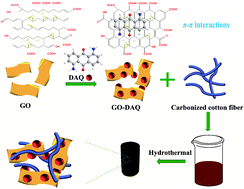An anthraquinone-decorated graphene hydrogel based on carbonized cotton fibers for flexible and high performance supercapacitors
Abstract
Cotton is an inexpensive natural product, which is mainly composed of cellulose fibers. Here, based on carbonized cotton fibers as substrates, we report a simple and facile method for the fabrication of a modified porous graphene hydrogel electrode. The method involved addition of 1,5-diaminoanthraquinone (DAQ) onto graphene to obtain a decorated graphene hydrogel electrode. DAQ is uniformly anchored on graphene sheets by π–π interactions. A robust and flexible DAQ–CGH hydrogel electrode is prepared by a hydrothermal method and optimized through different mass ratios. The carbonized cotton fiber substrate guarantees high mechanical strength, meanwhile the conductive graphene sheets serve as an electron transport medium for DAQ to ensure its remarkable pseudocapacitance. The DAQ–CGH composite exhibits a high specific capacitance of 490.2 F g−1 at 1 A g−1 with a stable capacity retention of 89.93% after 10 000 cycles at 5 A g−1 and excellent mechanical flexibility (about 92.15% of its original capacitance after 1000 bending cycles). Moreover, the assembled DAQ-2-CGH SCs achieve a high energy density of 36.18 W h kg−1 and power density of 2145.53 W kg−1.

- This article is part of the themed collection: Organic Materials for Energy Conversion and Storage


 Please wait while we load your content...
Please wait while we load your content...